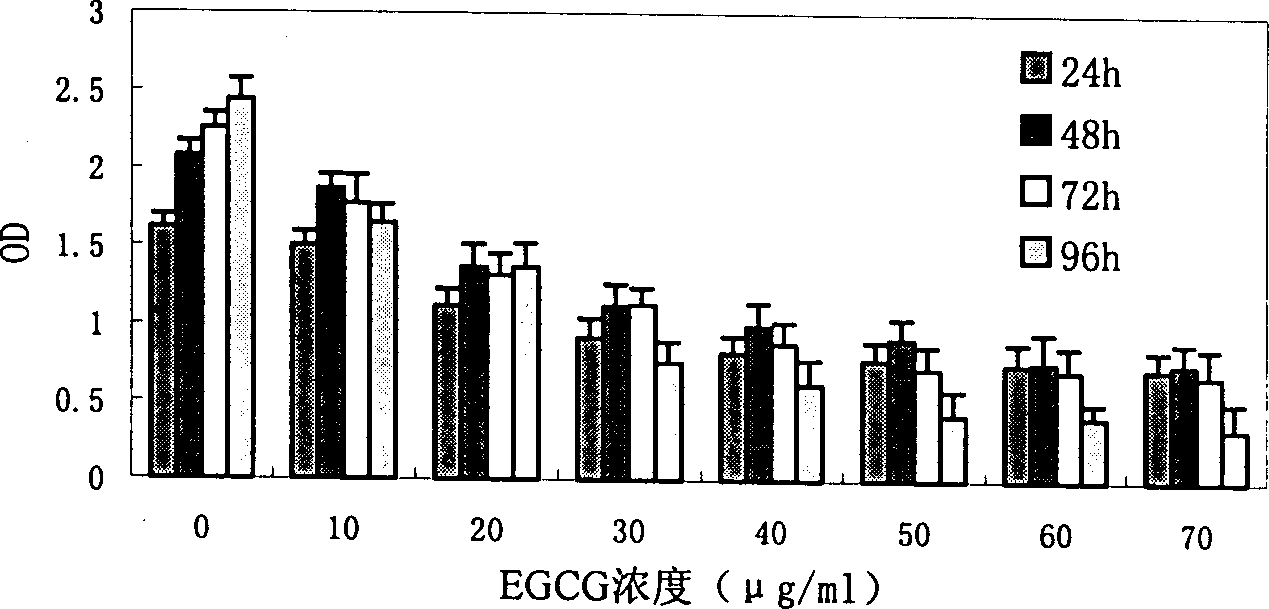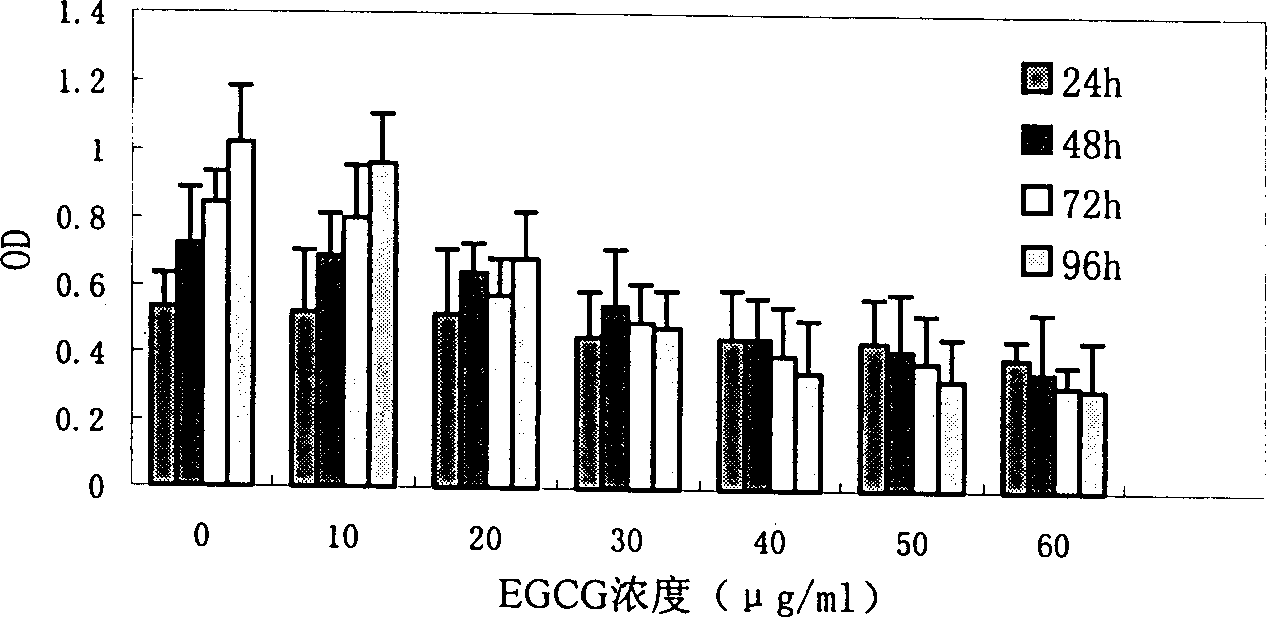Application of Epigallocatechin gallate (EGCG) in anti-tumor medicine
A technology of epigallocatechin and gallate, applied in the field of epigallocatechin gallate, can solve problems such as undeveloped success, achieve good application prospects, improve sensitivity, and enhance the effect of effect
- Summary
- Abstract
- Description
- Claims
- Application Information
AI Technical Summary
Problems solved by technology
Method used
Image
Examples
Embodiment 1
[0016] Cytotoxic effects of EGCG on MDR cells (KB-A-1) and drug-sensitive cells (KB-3-1).
[0017] EGCG was purchased from Sigma, and diluted to the required concentration with DMEM culture medium. The cytotoxic effect of EGCG on MDR cells (KB-A-1) and drug-sensitive cells (KB-3-1) was determined by thiazolium blue (MTT) rapid colorimetric method. Cells in logarithmic growth phase 10 4 cell ml -1 Inoculate in a 96-well culture plate, 0.2ml per well, add a certain concentration of TP and EGCG respectively, parallel 4 wells for each concentration, add an equal volume of culture medium to the control group, and place at 37°C, 5% CO 2 Incubate in an incubator with saturated humidity for 1-4 days, add 5mg·ml to each well 4 hours before the end of the experiment -1 MTT 10 μl, add 0.04N DMSO (dimethyl sulfoxide) to each well after the culture, 150 μl per well, shake for 10 minutes, the MTT reduction product is completely dissolved, use a BioRad550 microplate reader, use 550nm as ...
Embodiment 2
[0045] Comparison of drug resistance multiples between EGCG and traditional tumor chemotherapy drugs.
[0046] Adopt MTT method (referring to embodiment 1 for specific experimental operation) to investigate three kinds of anticancer drugs doxorubicin, colchicine and vinblastine that are more commonly used clinically under different concentrations and certain action time (three days) on KB-3-1 and the cytotoxicity of KB-A-1, plotting the different concentrations of the drug and the survival rate of the cells, determining the half inhibitory concentration of the cells, and calculating the resistance factor (RF=IC50(KB-A-1) / IC50 (KB-3-1)), and compared EGCG with the drug resistance multiples of these three traditional tumor chemotherapy drugs under the same action time. See the experimental results image 3 , Figure 4 , Figure 5 and the following table:
[0047] Table 3 Comparison of resistance multiples between EGCG and traditional tumor chemotherapy drugs
[0048] I...
Embodiment 3
[0054] Effect of EGCG on the anticancer effect of doxorubicin:
[0055] Cells in logarithmic growth phase 10 4 cell ml -1 Inoculate in 96-well culture plate, 0.2ml per well, first add 40μg / ml 10μg / ml EGCG to treat, then add doxorubicin, the concentration range is 0-32μg / ml, parallel 4 wells in each group, add the same amount to the control group volume of culture medium, placed at 37°C, 5% CO 2 and saturated humidity incubator for 3 days, add 5 mg·ml to each well 4 hours before the end of the experiment -1 MTT 10μl, add 0.04N DMSO (dimethyl sulfoxide) to each hole after the culture, 150μl per hole, shake for 10min, the MTT reduction product is completely dissolved, use BioRad 550 microplate reader, use 550nm as the experimental wavelength, 655nm as the experimental wavelength Measure the absorbance with reference to the wavelength, calculate the half inhibitory concentration (IC50), and calculate the reversal factor (reversal index.RI). See the experimental results Figu...
PUM
 Login to View More
Login to View More Abstract
Description
Claims
Application Information
 Login to View More
Login to View More - R&D
- Intellectual Property
- Life Sciences
- Materials
- Tech Scout
- Unparalleled Data Quality
- Higher Quality Content
- 60% Fewer Hallucinations
Browse by: Latest US Patents, China's latest patents, Technical Efficacy Thesaurus, Application Domain, Technology Topic, Popular Technical Reports.
© 2025 PatSnap. All rights reserved.Legal|Privacy policy|Modern Slavery Act Transparency Statement|Sitemap|About US| Contact US: help@patsnap.com



